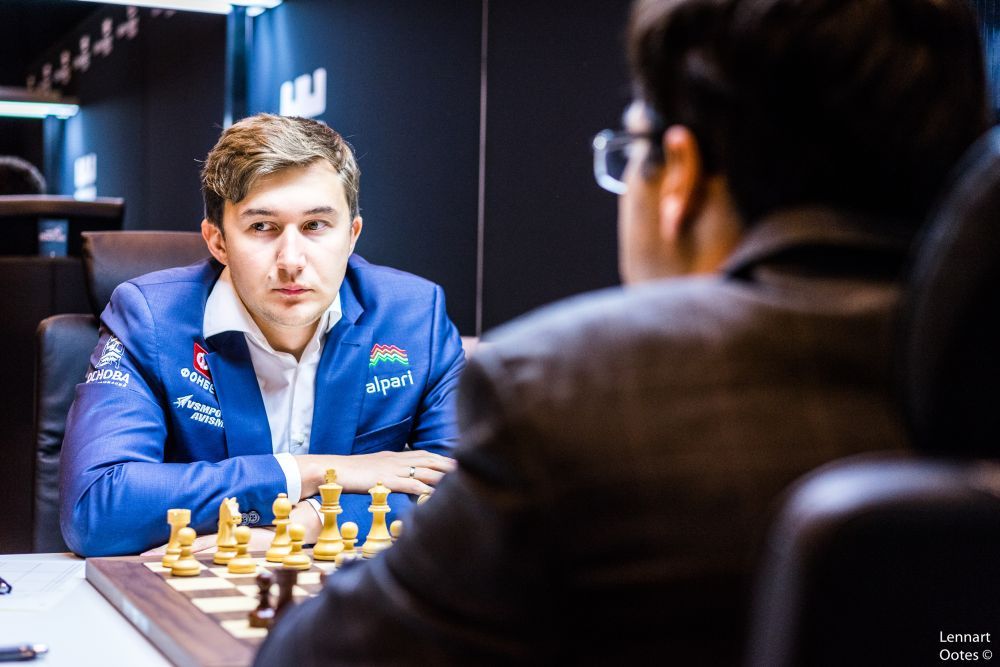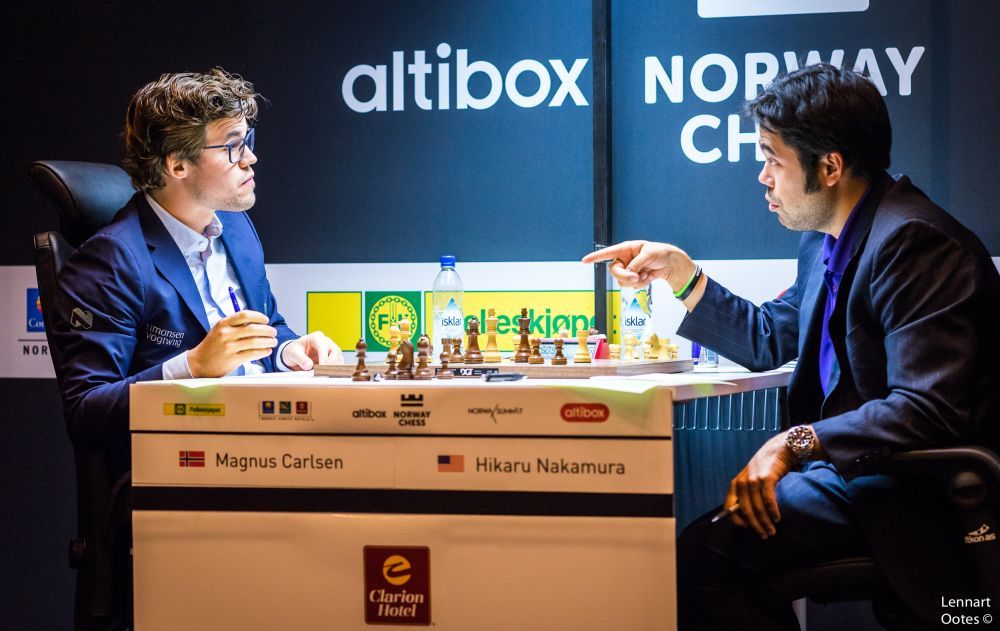Norway R03: Karjakin tests Anand's memory!
What's wrong with these super grandmasters, you may ask! All five games ended in a draw in the third round of the Altibox Norway Chess 2017. Well, that's what usually happens when roughly matched players fight against each other and match one good move with a better one! Carlsen against Nakamura was surely the most interesting game of the round, but Karjakin and Vishy was not without its moments. The Russian had some new ideas in the Berlin and pushed Anand on the backfoot. But the Indian was up to the challenge and steered the game to a draw. Photos, analysis, videos and much more.
Photos by Lennart Ootes

Round three at the world’s strongest tournament this year, the Altibox Norway Chess, looked like a seemingly uneventful affair at the outset as all of the games were drawn. But a closer look at the games unveils an entirely different picture. Vishy Anand, who sat down to play against Sergey Karjakin, chose the Berlin Defence to answer the Russian’s king’s pawn opening. Of course, playing the Berlin was Anand’s way of regaining composure. The opening is well known – or maybe, rather notorious – at the highest level because of the tepid positions it mostly leads to. But in his defense, he was playing with the black pieces, with which, it is difficult to press for a win at such elite level. And more importantly, having already lost a game in the previous round, being on the wrong end of a sharp tactical position would only have increased the damage.

However, the sneaky Russian had laid landmines for Anand even in an opening which is considered more or less neutralizing. Sacrificing not one, but two pawns early in the game, Karjakin went for a line which required the Indian megastar to be dead-on in his choice of moves in order to avoid ending up in a worse position. As the game began, Karjakin blitzed out almost every move showing that this was home preparation.
Somehow, one of the official commentators of the event, GM Nigel Short, figured out that this line might have been a remnant of Karjakin’s preparation for his World Championship Match against Carlsen held in November last year. When he was asked about this in the post-game press conference, Karjakin confirmed that GM Short was right. Curiously enough, Anand was able to come up with the most accurate moves as he also had prepared the same line with his second Radoslaw Wojtaszek some years ago, but didn’t remember all the moves correctly.
The game lasted 33 moves and the players were out of the playing hall in less than two hours having split the point. After the game, Vishy seemed to be satisfied with the result but at the same time complimented his opponent for his strategy of trying out this sharp line.
[Site "Stavanger NOR"]
[Date "2017.06.08"]
[Round "3.3"]
[White "Karjakin, Sergey"]
[Black "Anand, Viswanathan"]
[Result "1/2-1/2"]
[ECO "C67"]
[WhiteElo "2781"]
[BlackElo "2786"]
[Annotator "Sagar Shah"]
[PlyCount "66"]
[EventDate "2017.06.06"]
8. Rxe5 O-O 9. d4 Bf6 10. Re1 Re8 11. Bf4 Rxe1 12. Qxe1 Ne8 (12... Bxd4 13. c3
Bf6 14. Bxd6 cxd6 15. Na3 $44) 13. Nc3 Bxd4 14. Nd5 d6 (14... Bxb2 15. Rb1 Bf6
16. Qe4 $1 d6 17. Bd3 g6 18. Qxe8+ Qxe8 19. Nxf6+ Kf8 20. Nxe8 $18) 15. Bg5 f6
{This was already played in four games before.} 16. Bh4 $146 {This was
Karjakin's novelty.} (16. Be3 Be5 17. f4 Bxb2 18. Rb1 Ba3 19. Qa5 Bc5 20. Bxc5
dxc5 21. Qxc5 Qd6 22. Qxd6 cxd6 23. Ne7+ Kf7 24. Nxc8 Rxc8 25. Rxb7+ Rc7 26.
Rb2 f5 27. Bd3 $11 {1/2-1/2 (27) Andreikin,D (2733)-Jakovenko,D (2712)
Poikovsky 2016}) 16... Bxb2 17. Rb1 Be5 18. f4 c6 {The knight cannot move as
then the f4 pawn will fall.} 19. fxe5 cxd5 20. exf6 (20. e6 Qe7 $17) 20... Nxf6
{Black is two pawns up.} 21. Bd3 Bd7 22. h3 (22. Rxb7 Qc8 23. Rb1 Ne4 24. Bxe4
dxe4 25. Qxe4 Qc6 $11 {is even.}) 22... b5 (22... Bc6 {is also possible.}) 23.
Bxb5 Qe8 $1 {This forces the queen exchange.} 24. Qxe8+ (24. Qf1 $6 Bxb5 25.
Rxb5 Ne4 $15) 24... Bxe8 25. Ba6 Bg6 26. Bxf6 gxf6 27. Bb7 Re8 28. Bxd5+ {
White has recovered the pawns, Black has regained his activity. The game is
even.} Bf7 29. Bxf7+ Kxf7 30. Rb7+ Kg6 (30... Re7 31. Rxe7+ Kxe7 32. Kf2 {
Might be a dangerous endgame for Black to play.}) 31. Rxa7 Rc8 32. Rd7 Rxc2 33.
Rxd6 Rxa2 1/2-1/2

If facing the Berlin has always been an issue for you, then you could take a look at Shirov's 5.Re1 suggestion for White in this ChessBase DVD. It is a great way to play for just two results and Alexei's ideas are sure to give you an edge over your opponent.
Another interesting encounter was the one between the Russian veteran, Vladimir Kramnik and Wesley So. Kramnik, with his win against Anand in the last round, has moved up to the world number two spot in live ratings. And incidentally, So is the player whose rating he has surpassed to become the world number two! They played a long, tenacious game which lasted more than five hours in which Kramnik kept pressing with the white pieces for almost the entire game but Wesley never really let his position go out of hand.
Fabiano Caruana chose to kick off with the Petroff Defense against Maxim Vachier-Lagrave’s 1. e4. The two Grandmasters fought a 51-move-battle until there were only two kings left on the board. Compared to the other games of the round, this one was a bit dull.
Levon Aronian and Anish Giri fought a fierce duel which cropped out of a Queen’s Gambit Declined. On move 15, Giri, playing with the black pieces, made a covert draw offer by moving his queen back and forth. However, Aronian chose not to repeat moves and soon the game turned sharp as both players attacked their opponent’s king. By move 30, queens were exchanged and a few moves later Aronian found himself in horrible time trouble. At one point he had to make five moves in just nine seconds left on his clock with no increment.
It must be mentioned at this point that the time control for the tournament is 100 minutes for the first forty moves. After 40 moves are played, another 50 minutes are added for 20 moves. And if the game goes even longer, 15 minutes are added for the rest of the game, starting from move 61.
Aronian, in this case had made 35 moves when he had 9 seconds remaining. Giri tried to put pressure on him but the Armenian turned out to be resourceful. And once he’d reached move 40, the worst was over for him and the players drew by repetition in 53 moves.

The game between Magnus Carlsen and Hikaru Nakamura was probably the sharpest and the most entertaining. Playing a modest fianchetto with the white pieces against Nakamura’s Sicilian Najdorf, Carlsen played 11. b3 to stop the black knight from reaching the active c4 square. Soon he gained space and pushed Nakamura on the defensive. It was only through active moves and accurate defence that Hikaru was able to hold the draw.
[Site "Stavanger NOR"]
[Date "2017.06.08"]
[Round "3.1"]
[White "Carlsen, Magnus"]
[Black "Nakamura, Hikaru"]
[Result "1/2-1/2"]
[ECO "B90"]
[WhiteElo "2832"]
[BlackElo "2785"]
[Annotator "Ramirez Alvarez,Alejandro"]
[PlyCount "80"]
[EventDate "2017.??.??"]
this move is not very popular is that many consider 6.h3 to be more useful
generally than 6...a6 in the normal Dragon. That, however, is truly up to
debate.} 7. g3 Nc6 8. Be3 {An example of h3 being useful, normally this runs
into Ng4.} Bg7 9. Bg2 O-O 10. O-O Nd7 11. b3 Nxd4 12. Bxd4 Bxd4 13. Qxd4 {
Black plays unambitiously, hoping to defend a solid though slightly worse
position.} b6 14. Nd5 Bb7 15. c4 e5 {The weakness on d6 is not easy to target,
while Black hopes to use the break b5 and the control over the dark squares to
create counterplay.} (15... b5 {immediately was also possible.}) 16. Qe3 (16.
Qd2 {keeping pressure on d6 rather than on b6, seemed more logical. Black is
going to play b5 anyway.}) 16... b5 17. Rac1 bxc4 18. Rxc4 Bxd5 19. exd5 {
The eternal fight between the bishop and the knight. In this instance the
knight doesn't have many good anchor squares (it will get kicked out of c5 if
it goes there), on the other hand the bishop on g2 causes no great impression.}
a5 20. Rfc1 Nc5 21. a3 f5 $6 {Black gains space, but truly he simply weakens
his position.} (21... a4 {it's strange Nakamura did not go for this option} 22.
bxa4 $1 (22. b4 {strategically Black usually does not want to allow this, but
after} Nb3 {the knight heads for the d4 square}) 22... Qd7 {and the knight is
superb on c5.}) 22. b4 axb4 23. axb4 Nd7 24. Rc6 f4 25. gxf4 $1 {Black has to
decide how to lose a pawn} exf4 (25... Rxf4 26. Rxd6 Qe7 27. Re6 $1 Qxb4 28. d6
$1 {and with the bishop activated Black's position is difficult, but not
without resources:} (28. Rc7 {might be more precise}) 28... Ra3 29. Qe2 Qd4 {
with counterplay}) 26. Qe6+ Rf7 27. Qxd6 Qg5 {again Black finds resources.
Thanks to the exchange of the g-pawn, White's king is exposed and Nakamura
clings on to this as his hope to battle White's passed pawns.} 28. Kh1 (28.
Rc8+ Rxc8 (28... Kg7 29. h4 $1 {doesn't work for Black}) 29. Rxc8+ Kg7 30. Kh1
f3 31. Bf1 {was a better version of the game}) 28... f3 29. Bf1 Nf6 {The game
is certainly sharp. White is up material but his king is weak, and so are his
pawns. Black's king isn't particularly save either, and any move can be a
fatal mistake.} 30. Qe6 $6 {Now Nakamura finds strong counterplay} (30. Qg3
Qxg3 31. fxg3 Ra2 32. b5 Rb2 {is better for White, despite the passed position
of the f2 pawn}) 30... Kg7 {Unpinning the rook is an obvious start} 31. Rc7
Rxc7 $1 32. Rxc7+ Kh6 $1 {Black's king now hides on h6, where it is much safer
than on g8. With the weakness of White's king it is Carlsen that has to be
careful} 33. Qe1 Ra2 34. Re7 Ng4 {Forcing the result.} (34... Qxd5 {and Black
isn't in much danger, but he is not better either.}) 35. hxg4 Qh4+ 36. Kg1
Qxg4+ 37. Kh1 Qh4+ 38. Kg1 Qg4+ 39. Kh1 Qh4+ 40. Kg1 Qg4+ 1/2-1/2
Daniel King analyzes Carlsen vs Nakamura
Tomorrow is a rest day in Stavanger. Round 4 will begin on June 10, 2017 at 7:30 PM IST. After the rest day, Anand will have the black pieces yet another time against Anish Giri who is at the bottom of the table along with Anand with a score of 1.0/3. Nakamura and Kramnik are still leading the tournament with 2.0/3 while six players are tied for the second place with a score of 1.5/3.

Coverage on Firstpost:
Firstpost and ChessBase India have collaborated to bring you extensive and detailed coverage of the chess scene in India and internationally.

R1: Altibox Norway Chess: Viswanathan Anand should be buoyed by draw with black pieces in 1st round
R2: Altibox Norway Chess: Viswanathan Anand hurt by misjudgment against Vladimir Kramnik in 2nd round
